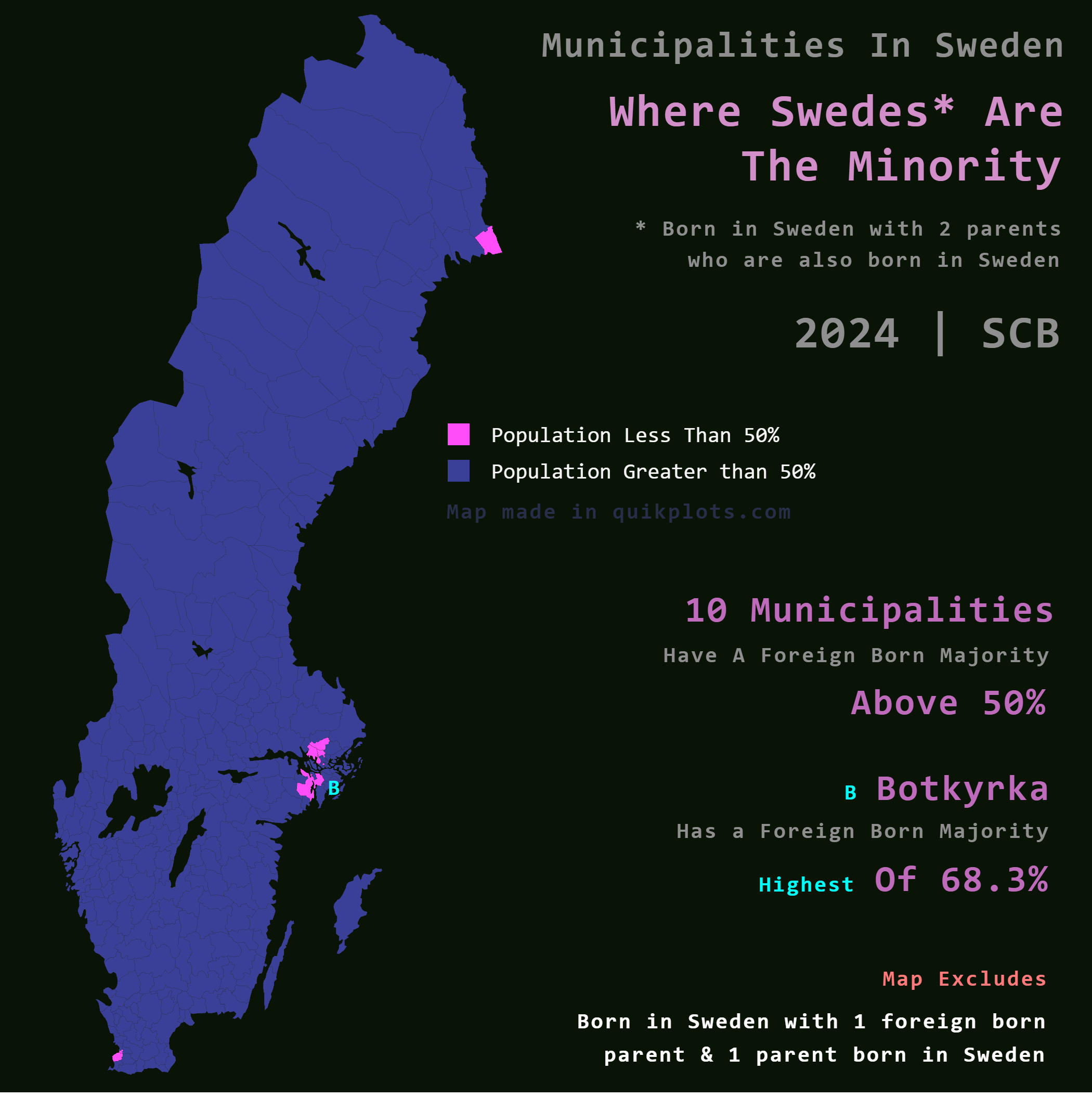Map of Municipalities with Foreign Majority in Sweden


David Chen
Data Visualization Specialist
David Chen is an expert in transforming complex geographic datasets into compelling visual narratives. He combines his background in computer science ...
Geographic Analysis
What This Map Shows
The map titled "Where Swedes are the Minority in Sweden" provides an intriguing look into the demographic landscape of the country. Specifically, it highlights the ten municipalities in Sweden where the foreign-born population surpasses that of the native Swedish population. This visualization is crucial for understanding the migration patterns and demographic shifts occurring within Sweden, especially as it relates to the ongoing discussions about migration and integration.
Deep Dive into Demographics in Sweden
Sweden is known for its liberal immigration policies and has been a destination for migrants from various parts of the world. The latest data from the Swedish Statistics Agency (SCB) reveals a nuanced demographic picture. While many areas in Sweden maintain a significant majority of Swedish-born citizens, there are pockets where the foreign-born population has outstripped the native Swedes.
The ten municipalities that are highlighted on the map include Upplands Väsby (46.8%), Jäfälla (43.6%), and Botkyrka (31.7%), among others. These percentages indicate that in these areas, the foreign-born residents and those born to foreign parents constitute a majority. It’s worth noting that the definition of foreign population includes individuals born in a foreign country as well as those born in Sweden with two foreign-born parents.
Interestingly, the demographic changes in these municipalities can often be attributed to various factors, including economic opportunities, educational institutions, and established immigrant communities. For instance, Malmö (45.7%) has a rich history of immigration, which has significantly influenced its cultural landscape. The city has become a melting pot of languages, traditions, and lifestyles, making it a vibrant example of multiculturalism in Sweden.
What’s fascinating is that the municipalities with a majority foreign population often face unique challenges and opportunities. Issues such as integration, social cohesion, and access to public services come to the forefront. Moreover, these areas may experience economic growth due to diverse skill sets brought in by migrants, contributing positively to the local labor market.
Regional Analysis
Looking closer at the map, we can analyze the geographical distribution of these municipalities. For instance, many of them are located in and around the Stockholm metropolitan area, which naturally attracts a larger influx of migrants due to its economic opportunities. Upplands-Bro (48.7%) and Jäfälla (43.6%) are situated near the capital, making them accessible for individuals seeking employment.
Conversely, municipalities like Haparanda (37.8%) are situated in the northern part of Sweden and have seen an influx of individuals from neighboring countries, particularly Finland. This regional dynamic illustrates how geography plays a significant role in migration patterns. The proximity to borders, urban centers, and economic hubs can greatly influence where migrants choose to settle.
Interestingly, while many municipalities have a predominately Swedish population, the presence of significant foreign communities in these ten municipalities suggests a shift in cultural dynamics. For example, Botkyrka (31.7%) has a rich cultural tapestry, influenced by its diverse population, which is reflected in local businesses, schools, and community events.
Significance and Impact
Understanding where foreign populations are the majority in Sweden is crucial for several reasons. Firstly, it sheds light on the integration policies and social dynamics within these communities. As immigration continues to shape Sweden's demographic landscape, it is essential to consider how these shifts affect local culture, economy, and social cohesion.
Moreover, discussions around migration often evoke polarized opinions. By providing data that shows a significant portion of municipalities still maintain a Swedish majority, it highlights the complexity of the narrative surrounding migration. The conversation needs to shift from viewing migration as a problem to recognizing it as an aspect of Sweden’s evolving identity.
Looking ahead, projections suggest that urban areas will continue to attract diverse populations, which will further influence local demographics. The challenge will be ensuring that integration policies are effective and that communities can thrive together, fostering mutual understanding and respect. As we move into 2024 and beyond, these municipalities stand as crucial case studies in understanding the future demographic landscape of Sweden.
Visualization Details
- Published
- October 6, 2025
- Views
- 8
Comments
Loading comments...